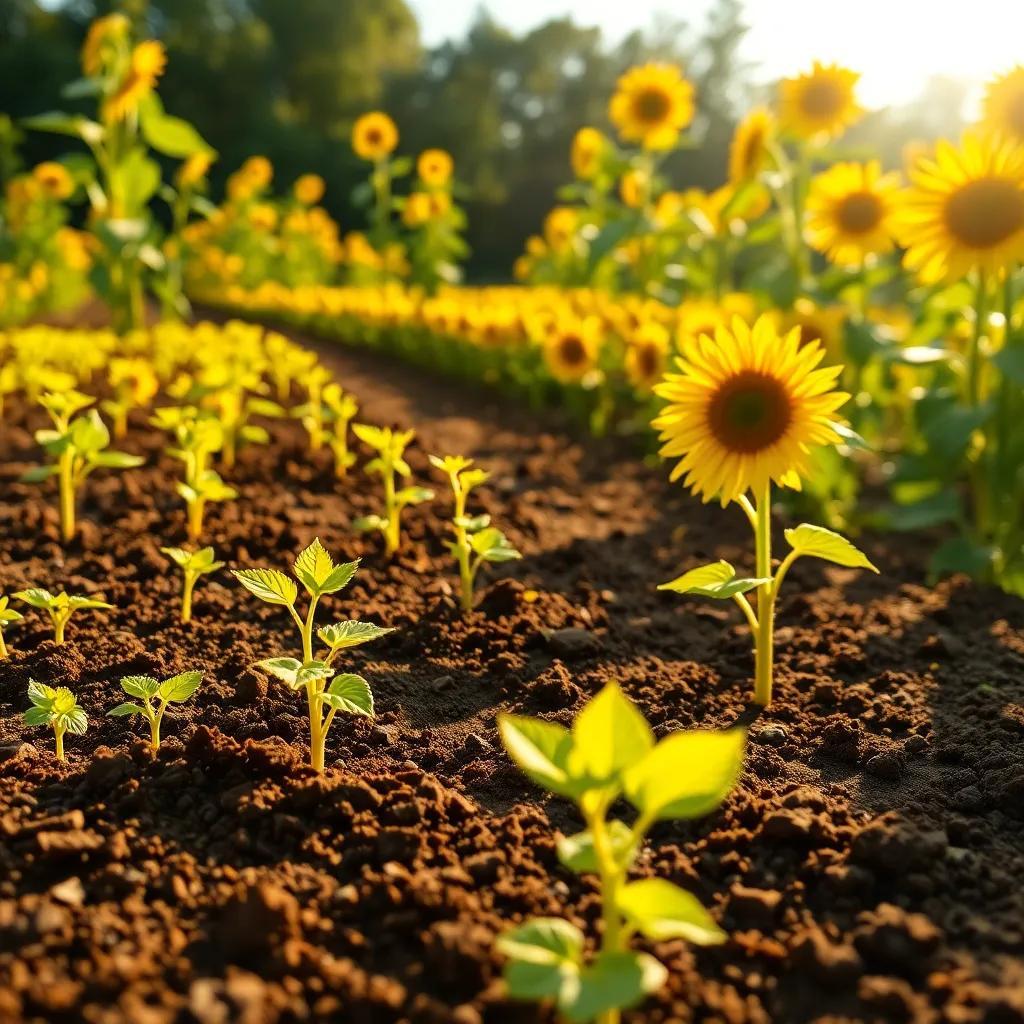Have you ever watched a sunflower grow and thought, “Wow, how does that happen?” Well, you’re in for a treat! In this guide, I’ll share the secrets of growing sunflowers from seed to stunning bloom, while also covering what they need to thrive and how to protect them from pests. Let’s dive into the sunny world of sunflowers together! 🌻
Understanding Sunflower Seed Growth Stages
When growing sunflowers, it’s a wild ride from seed to blooming beauty! Sunflower growth happens in several exciting stages. Let me break it down for you.
- Germination: This is where the magic begins! After you plant the seeds, they’ll sprout in about 7 to 10 days, given the right conditions. You’ll see tiny shoots breaking through the soil, reaching for the sunlight! It’s like they’re waving hello!
- Seedling Stage: Once the seedlings emerge, they start to grow leaves and strengthen their tiny stems. This usually takes a couple of weeks. During this time, sunlight and water are key. The little plants really soak it all up!
- Vegetative Growth: Now, this is where things get serious. Over the next few weeks, the plant will grow taller and produce more leaves. They are like eager teenagers—eating up all the nutrients! Healthy soil is the secret sauce here. If your sunflowers are happy, they’ll grow robust and ready for the next stage.
- Flowering Stage: After several weeks full of sunshine and care, your sunflowers will finally start to bloom! This is the crowning moment, usually about 60 to 90 days after planting. The bright yellow petals will open up wide, attracting all sorts of buzzing friends like bees and butterflies!
- Maturation: After the flowers dance in the sun for a while, they begin to fade. This is when the seeds develop inside the flower heads. It’s a sight to behold! You’ll want to keep an eye on the seed heads, as they’ll start turning brown when it’s time to harvest.
By understanding these stages, you can create the best environment for your sunflowers! Each step is essential for a healthy plant and a bountiful harvest. So, roll up your sleeves and let’s get growing!
Essential Conditions for Successful Growth
Alright, let’s get down to business! Do you want your sunflowers to grow tall and proud? Then you need to set them up for success! Here are some essential conditions to keep in mind:
- Sunlight: Sunflowers are like sun-worshippers! They need at least 6-8 hours of direct sunlight each day. So, find a nice sunny spot in your garden—maybe it’s a super sunny corner that always seems to shine!
- Soil Quality: Think of soil as the sunflower’s home. It should be well-draining and rich in nutrients. A mixture of sandy and loamy soil works wonders! You can also mix in some compost to help the soil breathe and feed those roots!
- Watering: Wow, what a thirst! Sunflowers love to drink, especially during dry spells. Aim for a deep watering about once a week. Just make sure not to drown them! Too much water can lead to root rot.
- Temperature: Sunflowers enjoy warm weather. They thrive in temperatures between 70°F and 85°F (21°C – 29°C). If it’s too cold, they might sulk and grow slowly. Choose the right time to plant, and you’ll be golden!
- Spacing: Don’t overcrowd these beauties! Give them plenty of space to stretch their leaves and grow. Aim for about 1-2 feet apart so they don’t end up arguing over sunlight and nutrients!
By creating these ideal conditions, your sunflowers will flourish, standing tall and bright! So, take a moment to prepare your garden, and get ready to watch those sunflowers smile back at you! 🌻🌞

Watering and Nutrient Needs for Sunflowers
Let’s talk about the golden rule for growing sunflowers: they love to drink and eat! Just like us, these cheerful flowers need water and nutrients to grow healthy and strong. Giving them the right amount of both will keep your sunflowers happy and blooming!
Watering Tips
- Frequency: Sunflowers love deep, occasional watering. Aim to water them about once a week, especially during dry spells. If it’s super hot outside, they might need more frequent drinks!
- Method: Water the base of the plant rather than the leaves. This way, the moisture goes directly to the roots where it’s needed the most! 🌧️
- Signs of Thirst: Look out for drooping leaves or dry soil. If your sunflowers are showing these signs, it’s time to give them a good soak.
Nutrient Needs
To really fuel their growth, sunflowers need a mix of nutrients:
- Nitrogen: Helps with leafy growth. You can add some compost to the soil before planting.
- Phosphorus: Important for strong roots and flowers. Consider using a balanced fertilizer!
- Potassium: Aids overall plant health. Make sure your fertilizer has this too!
Feeding Schedule
- Pre-Planting: Mix compost into your soil to boost nutrients.
- Growing Season: Feed your sunflowers every 4-6 weeks with a balanced fertilizer. Just follow the instructions on the package!
By keeping your sunflowers well-watered and well-fed, you’ll be rewarded with a garden full of vibrant blooms. Just imagine these sunny faces swaying in the breeze—talk about happiness!
Pest Management for Healthy Sunflower Plants
Growing sunflowers can be pure joy, but let’s be real—pests can crash the party! Don’t worry! With a little watchfulness and care, we can keep these little critters at bay and let your sunflowers shine!
Common Pests
- Aphids: These tiny pests love to munch on sunflower leaves. They’re often green or black and can multiply quickly!
- Caterpillars: These munchers can devour leaves and might even hide on the underside of leaves.
- Beetles: They love to feast on the petals and leaves, so keep an eye out for them.
Prevention and Control
- Regular Inspections: Check your plants weekly for any signs of pests. Early detection is key!
- Natural Remedies: If you spot pests, here are a few safe methods to send them packing:
– Handpicking: For caterpillars, just remove them from the plant.
– Insecticidal Soap: Spray this on affected areas to eliminate aphids without harming your flowers.
– Neem Oil: This natural pesticide can help keep pests away—just mix it with water and spray!
Attracting Beneficial Insects
Let’s invite some friendly helpers to the garden! Ladybugs, lacewings, and parasitic wasps love to eat pests. By planting flowers nearby, like marigolds, you can attract these beneficial insects to your garden!
Taking care of your sunflowers means being on the lookout for pests, but don’t let it stress you out! With a little vigilance, your sunflowers will thrive and dazzle in your garden!
Harvesting and Storing Sunflower Seeds Properly
Now, we’ve reached the moment we’ve all been waiting for: harvesting sunflower seeds! This is where we get to enjoy the fruits of our labor. With a little guidance, you’ll be a pro at harvesting and storing those seeds!
When to Harvest
- Timing: Wait until the back of the sunflower head turns yellow or brown. This usually happens about 30 to 45 days after the flowers start fading.
- Check the Seeds: The seeds should feel firm and dry when you squeeze them. If they feel soft or squishy, they’re not ready yet!
Harvesting Steps
When it’s finally time to harvest, follow these steps:
- Cut the Heads: Use sharp scissors or pruning shears to cut the sunflower heads. Leave about 12-18 inches of stem for easy handling.
- Drying: Hang the seed heads upside down in a warm, dry place. This helps them dry out completely over 2-3 weeks.
- Removing Seeds: Once dried, rub the heads gently to release the seeds. You can use a bucket to catch them as you work!
Storing Seeds
- Cleaning: Clean any chaff or debris from the seeds by rinsing them in water. Viable seeds will sink, while chaff floats!
- Storage: Keep your seeds in an airtight container in a cool, dark place. They’ll last for several months, ready for your next planting adventure or as a tasty snack!
Harvesting sunflower seeds is incredibly rewarding! Not only can you use them for planting next season, but they also make a nutritious snack. So, get ready to celebrate your hard work with a wonderful harvest! 🌻🌱

